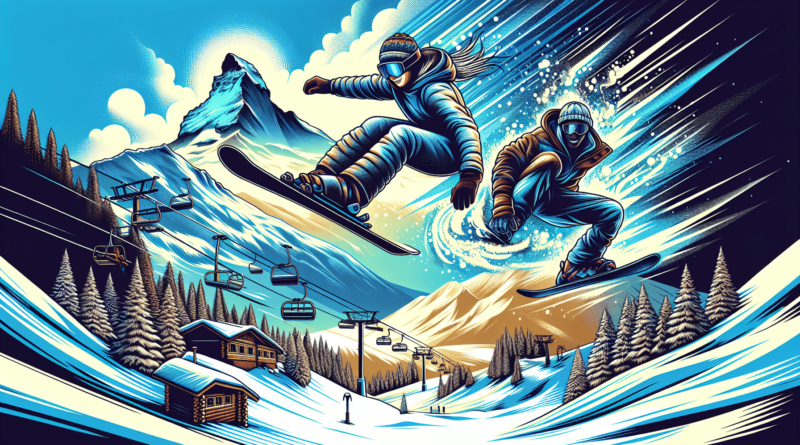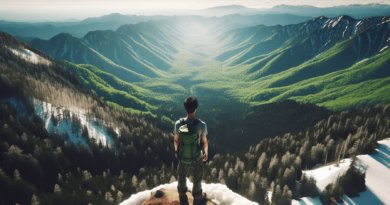Skiing And Snowboarding
Buckle up for a thrilling journey down the frost-kissed slopes as you immerse yourself in the exhilarating world of skiing and snowboarding. You’ll get a taste of the adrenaline rush offered by these winter sports, the moments of breathless awe amidst pristine snowy landscapes, and the camaraderie among enthusiasts that makes these adventurous experiences even more worthwhile. Be prepared to strap on your gear and hit the slopes as you navigate the nuances of skiing and snowboarding.

The Basics of Skiing
Skiing is a fantastic sport, filled with adrenaline and thrills, that transports you within the middle of astounding nature settings. It’s a winter activity where you slide over snow using skis strapped onto your feet. Learning the basics is the foundation to progressing in the sport and enhancing your skill set.
Different Styles of Skiing
There are several types of skiing, and each one brings a unique spin to the ski experience. Some widely recognized styles include Alpine or downhill skiing, freestyle skiing, cross-country skiing, and telemark skiing. Each style has its unique characteristics and involves different techniques, terrain, and equipment.
Equipment Needed for Skiing
To get started with skiing, you need some essential pieces of equipment. You’ll need skis, ski boots, and poles. The boots should be fitted comfortably, and the skis should match your height and skiing style. In terms of safety equipment, a helmet is mandatory, and it’s a good idea to invest in a quality pair of goggles and skiing-specific clothing.
Beginner Tips for Skiing
When you’re just starting, skiing can seem daunting. But don’t worry. Firstly, take a lesson from a certified instructor to learn the basics correctly and safely. Familiarize yourself with your equipment and always be aware of your surroundings. Remember buddy system while skiing to keep safe and encourage each other.
The Basics of Snowboarding
Snowboarding, just like skiing, is all about the thrill of descending snow-covered slopes. But instead of two skis, you use a single snowboard attached to your feet. The techniques and styles vary, making it a diverse and exciting sport.
Difference between Skiing and Snowboarding
The main difference between skiing and snowboarding lies in the equipment used and how you navigate the slopes. In skiing, your legs are separated, and you direct yourself with poles. In contrast, with snowboarding, both feet are attached to a single board, and your balance and body movements control your direction.
Equipment Needed for Snowboarding
To get started with snowboarding, you’ll need a snowboard, snowboarding boots, and snowboarding specific clothing. Choosing the right board is essential. Also, just like skiing, investing in a well-fitted helmet and quality goggles is crucial for safety.
Beginner Tips for Snowboarding
Starting with snowboarding could be tough, but it gets easier with time. Lessons from a certified instructor can make the learning curve less steep. It’s essential to get comfortable with the feel of having both feet strapped to a single board. Start with easy slopes and progressively challenge yourself as you gain confidence.
Key Techniques for Skiing
Once you’ve got the basics down, it’s time to start improving your technique and building up your skills.
Mastering the Plough
The plough, or snowplough, is a beginner skiing technique where the skis are arranged in a ‘V’ shape, helping control speed and direction. It’s your first step to gain control and confidence on the slope.
Effective Carving Techniques
Carving is where you make your turns by digging the edges of your skis into the snow. It’s a crucial technique to master for more precise control and speed regulation. Remember, the sharper the angle, the easier the turn will be.
Tips for Skiing on Different Types of Snow
Different types of snow conditions call for different skiing techniques. Loose powder is usually the most friendly, while icy or slushy conditions can be challenging. No matter the type of snow, always be aware of your surroundings and adjust your approach to match the conditions.
Importance of Good Body Position
Simply put, your body position can make or break your skiing experience. Maintain a comfortable stance, keep your body facing downhill, bend at the knees, and lean forward slightly. Proper balance and body position can significantly enhance your control and performance while skiing.
Key Techniques for Snowboarding
When you’ve mastered the basics of snowboarding, it’s time to start honing your technique.
Understanding Weight Distribution
When snowboarding, the way you distribute your weight impacts your control. Shifting your weight to your front foot allows for smoother turns, while leaning on your back foot can help slow down.
Mastering the Ollie and Nollie
An Ollie is a snowboarding technique where the rider leaps into the air without utilizing a jump. A Nollie is similar, except you leap off the nose of the board instead of the tail. Both tricks are snowboarding fundamentals which provide a foundation for more complex moves.
Tips for Snowboarding on Different Types of Snow
Much like skiing, different types of snow require different snowboarding techniques. Powder snow is typically the most enjoyable to ride on, while icy conditions can be more challenging. Always be aware of the changing snow conditions and adjust your ride accordingly.
Importance of Good Body Position
Having a proper body position is just as important in snowboarding as it is in skiing. Keep your body facing the direction you’re going, bend your knees slightly, and keep your weight centered over the board. This will help improve your balance, control, and overall performance on the mountain.
Fitness and Conditioning for Skiing and Snowboarding
Both skiing and snowboarding are sports that require good physical condition.
Exercises to Improve Skiing Ability
To be a strong skier, you’ll need strength, balance, flexibility, and endurance. Consider exercises that target these areas, like squats, lunges, core workouts, interval training for cardio, and regular stretching to enhance your flexibility.
Exercises to Improve Snowboarding Ability
For snowboarding, focus on exercises that improve balance, flexibility, strength, and agility. This might include balance board exercises, high-intensity interval training, yoga for flexibility, and weight training to build core and lower body strength.
Importance of Flexibility and Mobility for Winter Sports
Flexibility and mobility are essential in skiing and snowboarding, as they impact your ability to execute techniques and decrease your risk of injuries. Regular stretching can enhance your performance and help you maintain effective control over your movements.
Injury Prevention Tips
Preventing injuries is just as crucial as improving your ability. Always start with a proper warm-up, gear up correctly with protective equipment, and take plenty of rest to avoid fatigue-related injuries. Listen to your body, and never push yourself beyond your limit.
Mountain Safety
Mountains are fun and exciting, but they can be dangerous too.
Understanding Mountain Hazards
Before you hit the slopes, it’s important to understand potential hazards like avalanches, sudden weather changes, and natural obstacles. Take the time to learn about these hazards and how to navigate them safely.
Precautions to Take When Skiing
While skiing, stay on marked trails, wear a helmet, ensure your equipment is properly fitted, and avoid skiing alone in unfamiliar areas.
Precautions to Take When Snowboarding
The same precautions apply to snowboarding. Stick to your comfort zone, always keep emergency contact information handy, and most importantly, know your limits.
Responsibility Code
The responsibility code is a set of rules that everyone should follow on the slopes. It emphasizes safety for you and the people around you. This includes staying in control, giving way to people in front, and respecting all signs and closures.
Skiing and Snowboarding Terminology
Understanding the language can help you get the most from your skiing or snowboarding experience.
Common Skiing Terms
Some common skiing terms you might come across include ‘Piste’ (a marked ski run), ‘Powder’ (fresh, untouched snow), ‘Mogul’ (a mound of snow made by skiers), and ‘Off-Piste’ (unmarked area off the designated trails).
Common Snowboarding Terms
Snowboarding has its jargon too, which includes ‘Regular’ (left foot forward), ‘Goofy’ (right foot forward), ‘Stance’ (how a rider stands on the board), and ‘Grind’ (sliding along an object on the snowboard).
Understanding Snow Conditions and Weather Terms
Familiarizing with terms describing snow conditions and weather, such as ‘Corn’ (wet, loose, granular snow), ‘Crud’ (powder snow that has been skied over), ‘Hardpack’ (surface that’s been packed down and is more solid), and ‘Whiteout’ (dense fog or falling snow that reduces visibility), can help you navigate the mountain more effectively.
Skiing and Snowboarding Etiquettes
Respecting the rules and others around you ensures a safe and enjoyable experience for everyone.
Rules of the Slope
Each ski resort has its own set of rules, but some common ones include staying in control, not stopping in a place where you’re not visible to others, and giving people ahead of you the right of way.
Respecting Others on the Mountain
Respect for others is crucial. Don’t cut people off or stop unexpectedly. Be mindful of beginners and provide them with adequate space. Always offer help if you see someone in trouble.
Lift Line Etiquettes
Being polite in the lift line goes a long way. Wait your turn, make space for others, and load and unload promptly.
Choosing A Ski Resort
Your choice of ski resort can greatly impact your skiing or snowboarding experience.
Factors to Consider When Choosing a Ski Resort
Consider factors like the resort’s location, the difficulty of the slopes, the amenities available, and your budget.
Comparing the Skiing and Snowboarding Facilities of Different Resorts
Different resorts have different facilities. Some might have a wide variety of slopes for both skiing and snowboarding, others might specialize more in one or the other.
Family-Friendly Ski Resorts
If you’re planning to vacation with the family, it’s important to find resorts offering family-friendly amenities like gentle slopes, kids’ ski lessons, and entertainment.
Future of Skiing and Snowboarding
The future of these winter sports is promising with plenty evolving trends and innovations.
Advancements in Skiing and Snowboarding Equipment
Gear and equipment for both sports are advancing, with improvements being made for better safety, comfort, and performance. Expect to see more innovative ski and snowboard designs, boots, and clothing.
Climate Change and Its Effects on Skiing and Snowboarding
Climate change is a significant concern for all snowy sports. Warming temperatures are leading to shorter winter seasons and less predictable snowfall. This could have profound effects on the future of skiing and snowboarding.
The Increasing Popularity of Freestyle Skiing and Snowboarding
Freestyle skiing and snowboarding, involving tricks and jumps, are seeing increased popularity. As extreme sports continue to gain traction, expect to see more people take to the slopes to showcase their daring stunts.



